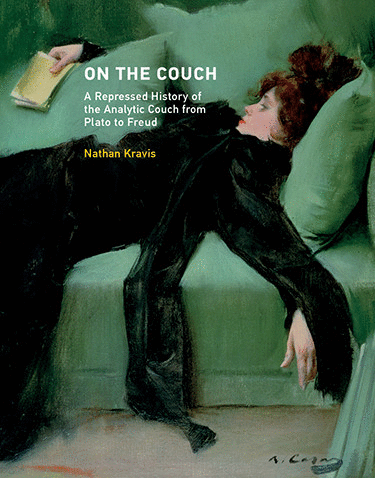On the Couch: A Repressed History of the Analytic Couch From Plato to Freud

For anyone interested in the history of psychiatry and psychoanalysis, Nathan Kravis’ book will be illuminating. In On the Couch: A Repressed History of the Analytic Couch From Plato to Freud, Kravis delivers an engaging glimpse into the background—the artistic, cultural, social, and intellectual history—behind Freud’s introduction of the analytic couch in the psychoanalyst’s office.
For sure, Kravis acknowledges that many analysts and therapists today are ambivalent about using the couch. Most of us do not know anything more about its backstory than Freud’s movement from hypnosis with patients reclining on the couch to his analytic method of having his patients recline while using “free association” to further their introspection. In 20th- and 21st-century culture, the couch has become the icon of introspection, self-observation, and an interior life. Kravis illustrates these points with marvelous pictures and illustrations gathered from numerous museum collections, newspapers, and magazines. He even shows us a New York City subway poster from the 1990s depicting a classic Victorian couch with the caption, “Some people find the same peace of mind sitting in a pew. Come home at Easter. The Catholic Archdiocese of New York.” Some therapists may eschew the use of the couch, but New York City citizens certainly know what it represents in popular culture!
More seriously, using photographs of beautiful objects from the ancient world, Kravis takes us through the history of reclining as a social phenomenon. These illustrations include funerary steles and urns from ancient Rome to pottery illustrating the symposium from the Greek period. Examining these works of art reveals that middle- and upper-class Greeks, Romans, and Jews reclined while eating and conversing—a sign of status in the ancient world. We learn that in the fifth century B.C., men went to special temples to be visited by gods in their dreams and then to have their dreams interpreted by priests. This certainly predated by several millennia Freud’s method of dream interpretation.
Couches, sofas, and divans are well illustrated through the centuries, denoting the association with social status, luxury, and prominent social class in the early centuries to sleeping and sexual fantasy and activity in more recent years. Presented are images of the purity of the Virgin in Medieval and Renaissance art to admiring images of the female body reposing on a couch after the Enlightenment. Think of Jean-Auguste-Dominique Ingres’ Odalisque with Slave (1839–1840) or Edouard Manet’s Olympia (1863), both of which are discussed in the book.
As a true psychoanalyst, Kravis draws our attention to what the furniture represents and what the artists who depict the reclining position are conveying; that is, the interiority and introspection of both the subject and the viewer. In looking at many of the images, the viewer cannot help but reflect on what is happening in the reclining subjects’ minds—their thoughts, fantasies, intentions, and expectations. In doing so, the viewer must then reflect on what is happening in her own mind.
Finally, Kravis takes us through the history of reclining furniture used as part of the healing process. From obstetric chairs and tables to examination tables, reclining furniture was intended to enhance relaxation and repose, and doctors and healers have long used recliners to treat and heal their patients. Before antibiotics, for example, many generations of tuberculosis patients were sent to sanitoria to rest and heal. For psychiatrists, the “rest cure” for serious mental illnesses evolved into the “talking cure” of Breuer and Freud.
It is no wonder then that Freud, with his deep interest in the ancient world, a doctor in 19th-century Vienna, and a citizen of the Viennese haute bourgeoisie, would have furnished his office with a reclining divan that was covered with oriental rugs. It would have served a number of purposes. Using the couch or divan combined healing with Freud’s belief that it enhanced his patients’ focus on their interior lives. Kravis reminds us that in French the couch is called a “lit de repose,” which he says “suggests a tie to asylum treatments, rest cures, sanatoria and nineteenth-century psychiatric traditions of somatic and hypnotic treatment” (p. 137).
I highly recommend this gem of a book for anyone interested in the history of psychiatry and psychoanalysis. It presents an artistic and cultural context for the couch as an icon of introspection and self-discovery.



